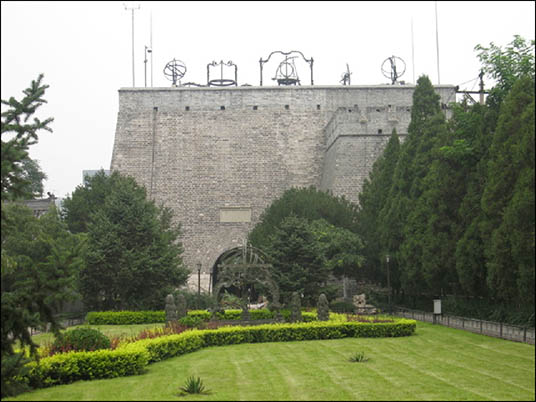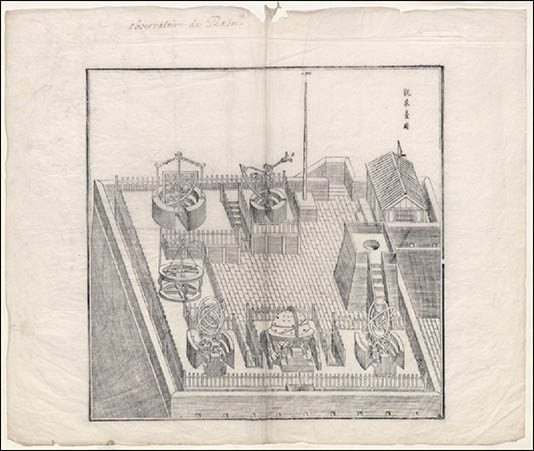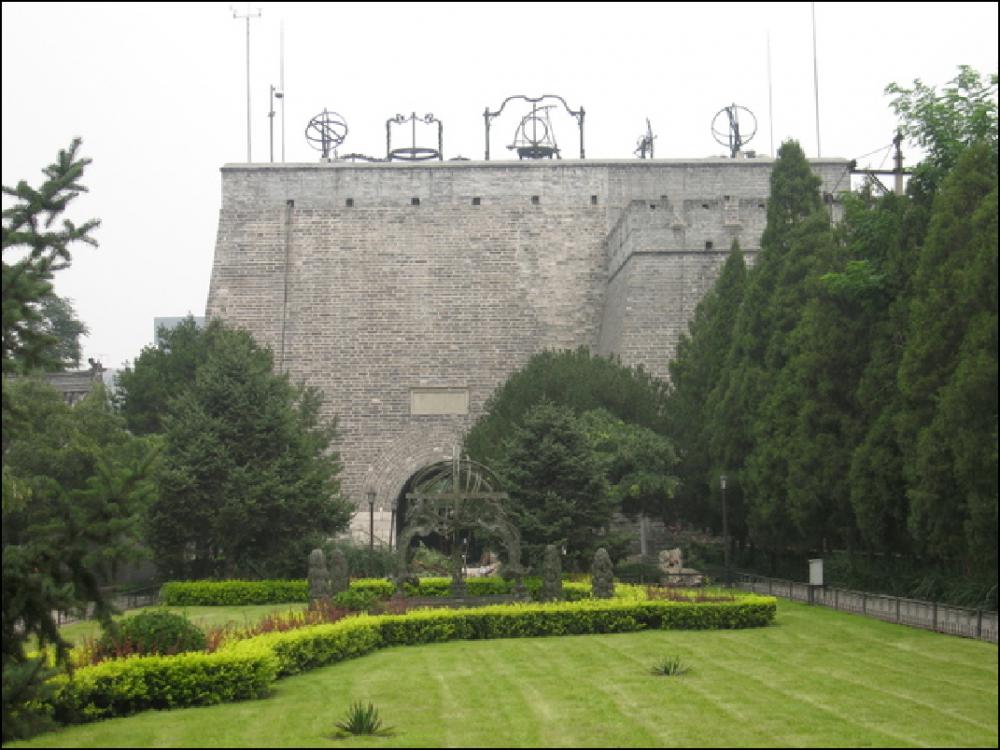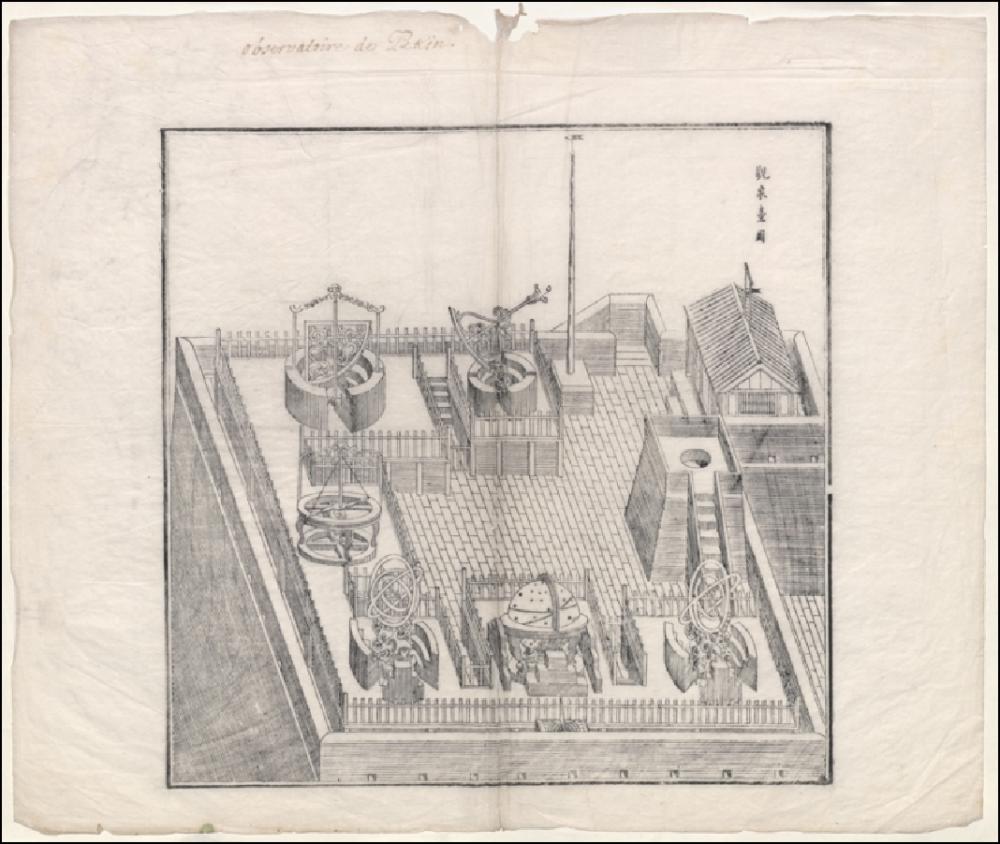
Category of Astronomical Heritage: tangible immovable
Beijing ancient observatory, China

Presentation
Geographical position
The Beijing Ancient Observatory is located in Beijing, the capital city of the Jin (1115-1234CE), Yuan (1271-1368CE), Ming (1368-1644CE) and Qing (1644-1912CE) dynasties. The name of the city was Yanjing þçòõ║¼ in the Jin dynasty, and Dadu ÕñºÚâ¢, the Great Capital, in the Yuan dynasty.
Location
Latitude 39° 54′ 22″ N, longitude 116° 25′ 43″ E. Elevation 49m above mean sea level.
General description

Fig. 1. Plan of the site. © Authorised for non-profitable use

Fig. 2. The brick platform. © Authorised for non-profitable use
The observatory site covers an area of 10,000m². The brick platform of the observatory is 14m high and the top measures 20.4m from north to south and 23.9m from east to west. It used to be a part of the city wall once surrounding Beijing.
Brief inventory
On top of the platform are eight bronze instruments constructed in the Qing dynasty. Six of them were built by the Flemish Jesuit Ferdinand Verbiest (1623-88) in 1669:
- Chidao jingwei yi ÞÁñÚüôþ╗Åþ║¼õ╗¬, literally the instrument for equatorial longitude and latitude, or the equatorial armillary sphere;
- Huangao jingwei yi Ú╗äÚüôþ╗Åþ║¼õ╗¬, literally the instrument for ecliptic longitude and latitude, or the ecliptic armillary sphere;
- Tianti yi 天õ¢ôõ╗¬, literally the instrument of the celestial body, or the star globe;
- Diping jingyi Õ£░Õ╣│þ╗Åõ╗¬, literally the instrument for azimuth, or the azimuthal ring;
- Xiangxian yi Þ▒íÚÖÉõ╗¬, literally the quadrant instrument, or the quadrant; and
- Hushi yi Õ╝ºþƒóõ╗¬, literally bow and arrow instrument, or the sextant.
The other two instruments are:
- Diuping jingwei yi Õ£░Õ╣│þ╗Åþ║¼õ╗¬, literally the instrument for azimuth and altitude, or the azimuth quadrant; and
- Jiheng fucheng yi þÄæÞííµèÜÞ¥░õ╗¬, literally the divine instrument for pacifying luminaries.

Fig. 3. Verbiest’s illustration of the observatory (from a 17th-century European manuscript). Creative Commons Licence
The first of these was constructed by the Portuguese Jesuit Kilian Stumpf (1655-1720) between 1713 and 1715, while the maker of the latter is not clear. The seven instruments made by the two Jesuits are based on Tycho Brahe’s design but with Chinese decorations, while the last one belongs to the Chinese tradition but with a European system of graduation and sighting. Overall, the observatory is now the only example in the world that is equipped with Tychonic instruments.
History
The first observatory in Beijing was built in the Jin dynasty, but its position is not clear now. In 1279, by order of Kublai Khan, Wang Xun (þÄïµüé) and Guo Shoujing (Úâ¡Õ«êµò¼) built a new observatory just north of the present observatory. After the Ming capital moved from Nanjing to Beijing in 1406, a temporary observatory was set up on the city wall. The present brick platform was built in 1442 on a portion of the city wall that used to encircle the city. The whole city wall was removed after 1949 when the construction of the ‘new Beijing’ began, but the platform and some important gate towers have been preserved intact up to today except minor refurbishments. The observatory remained in use throughout the rest of the Ming and the whole of the Qing dynasties. After the founding of the Republic of China in 1911, it became the seat of the Central Observatory of the Kuomingtang government until 1927 when the Central Observatory moved to the Purple Mountains in Nanjing.
Authenticity and integrity
Today, the top of the platform is almost the same as in 1669 when Verbiest published the first illustration of the observatory, except for the addition of the two instruments built after 1713.
Documentation and archives
The history of the observatory, including the structure and usage of the eight instruments on top of it, is well documented in Chinese literature from the Ming, Qing and the Republic of China periods. Most of the original observational reports to the throne in the Qing dynasty are now well preserved in the First National Archives in Beijing.
Management and use
Present use
In 1982, the observatory was put on the list of key national cultural properties. Since 1983, it has been open to the public and has become a tourist destination in Beijing. Since 2008, it has been open to tourists free of charge. Presently the observatory forms part of the Beijing Planetarium.
Protection
The government provides regular funding for the observatory’s preservation, study and maintenance.
No multimedia content published
Currently there is no multimedia content published for this case study








